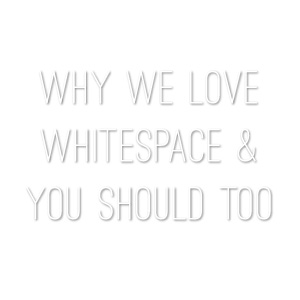First of all, what on earth is whitespace, right?
Simply put it's the space between elements in a layout, such as text or images. White space is not always white, it can be a color or subtle texture, but in any case, it is the space not occupied by text, images, or other key elements. Whitespace is not "empty space" or "wasted space", it's a fundamental and powerful design tool. Providing a little breathing room is essential to clarity, harmony and balance in design. You need to lead the reader's eye from one element to the next, making your content easier to follow and understand.
Let's use a metaphor to make the concept of whitespace a bit clearer. Imagine you walk into your friend's home and all of her furniture is pushed together so that it literally covers every inch of the floor (or almost every inch). The coffee table, chair, sofa, end tables, etc - all nearly touching each other. It would certainly stop you from just walking right in, wouldn't it! How do you enter the room? And once you're in, how do you navigate your way through? It would be overwhelming. Have you ever seen furniture arrangements where the sofa is used to divide a much larger space into two, so that you know you have gone from, say, the social area to the dining area? Now take this concept and apply it to paper or your computer screen.
By using white space in a thoughtful way, you can highlight and draw attention to the most important elements on the page, making the valuable information stand out and leading the viewer through your layout (just like rooms in a house). This ultimately translates to efficiency. Too much stuff on any given page makes it overwhelming, cluttered and difficult to follow. It takes away from what's significant and useful, and may cause your reader to walk away without ever reading or understanding your message.
Seems simple enough, right? Well, in essence, it is simple. However, it does get a little more complex when you consider the different types of available white space – macro & micro, active & passive. While we don't expect you to remember all these design intricacies (that's our job!), we do hope to shed a bit of light on why whitespace is so important and convince you to consider not cramming everything under the sun on one page.
Macro white space refers to grander areas of space between larger elements, such as images and full bodies of text. Micro white space, on the other hand, is the tiny areas between individual lines of text, words, and even between letters that can dramatically affect legibility and comprehension. Generally, having ample breathing room for your text makes your content easy on the eyes, and thus friendly and approachable. Just think of the last small, but fat book you started to read – pages crammed full of tiny text set close together. You try almighty hard to tear through the first page or two, but end up putting it down because it was just too hard to get through. Now, a book is something you actually wanted to read. What chance does an unsolicited marketing piece, web page, promotion, or ad stand if it is overflowing with content, but has very little or poor use of whitespace?
Active whitespace is just that–active. It dynamically and fluidly leads a viewer from one element to the next. Active white space is used in structure and design to add emphasis to certain areas. Passive whitespace refers to areas around the outside of a page and the areas intentionally left blank within the content itself, such as margins, and including things like line height and font weight. This is sometimes more of a byproduct of the layout, but nonetheless just as important as active white space, despite its misleading name.
Whitespace is used in every design. It simply has to be there–no matter what. The key is using it the right way and in the correct amounts. And if you ask me (which I assume you would because you're reading our blog), it seems these days many websites and printed materials often don't use enough whitespace.
So just remember, in the end, using large amounts of whitespace shouts, "This content is important! We want you to understand our message fully, clearly, and without distraction." It also conveys a certain stylistic elegance, openness and freshness, setting your business apart from those who aren't being thoughtful about their audience.
Simplicity, clarity, balance, harmony–it's all there for you, you just have to use it.
Have a Pawsitively Tail Waggin' Good Day!
P.S. This information was provided by Ruff Haus Design - Your Loyal Marketing Companion. Established in 1997, we are a special breed of full service graphic design company that works with a premier pack of clients. We bring a fresh outlook and tail-wagging enthusiasm to your marketing program. Learn more about how we can help improve your brand management and support your marketing needs at www.ruffhaus.com

